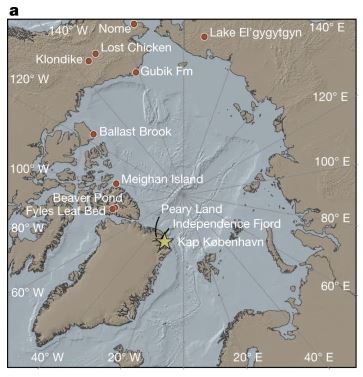The survival of some DNA for two million years is astounding all of itself — breaking the record for oldest known DNA by nearly a million years. Before this, the oldest DNA was thought to be 1.2 million years — beyond which all the global DNA of all the species that ever lived was assumed to be dissolved into unreadable mush.
But now we have found enough of the ancient code to identify a whole ecosystem on the northern edge of Greenland that no one expected to find. Apparently giant elephant-like Mastodons were wandering the far northern parts of Greenland — practically as close as they could get to the North pole without swimming.
At the time, the world was not just 1.5 catastrophic degrees warmer than today, but a full nuclear 10 to 17 degrees hotter.
Strangely life on Earth wasn’t suffering the sixth mass extinction.
Discovery of world’s oldest DNA breaks record by one million years
ScienceDaily
The incomplete samples, a few millionths of a millimetre long, were taken from the København Formation, a sediment deposit almost 100 metres thick tucked in the mouth of a fjord in the Arctic Ocean in Greenland’s northernmost point. The climate in Greenland at the time varied between Arctic and temperate and was between 10-17C warmer than Greenland is today. The sediment built up metre by metre in a shallow bay.
Scientists discovered evidence of animals, plants and microorganisms including reindeer, hares, lemmings, birch and poplar trees. Researchers even found that Mastodon, an Ice Age mammal, roamed as far as Greenland before later becoming extinct. Previously it was thought the range of the elephant-like animals did not extend as far as Greenland from its known origins of North and Central America.
Greenland two million years ago?

The American Mastodon by Charles R Knight (1897)
As exciting as this is, it’s awkward for the catastrophic narrative, since there was no catastrophe, so it was time to accidentally say what everyone was thinking and hose it down with the usual meaningless caveats:
“One of the key factors here is to what degree species will be able to adapt to the change in conditions arising from a significant increase in temperature. The data suggests that more species can evolve and adapt to wildly varying temperatures than previously thought. But, crucially, these results show they need time to do this. The speed of today’s global warming means organisms and species do not have that time so the climate emergency remains a huge threat to biodiversity and the world — extinction is on the horizon for some species including plants and trees.”
How exactly do these results show species “need time” to adapt to a warming of 0.13 degrees C per decade which is what we have today? It’s not like anyone anywhere, apart from God, has the full weather history of Greenland circa two million BC. There just isn’t the resolution to know how much things changed from the year two million and twenty to the year two million and ten. The climate could have been changing ten times faster than today and how would we know? All the spikes blend to nothing when the graph resolution has one dot every thousand years.
It’s not that we know the climate was changing rapidly then, but we know they don’t know. And yet they doth protest…
Information bonanza coming
If we can still find ancient DNA in clay and quartz it opens whole new fields of research in biology, evolution, and paleoclimate studies. The DNA won’t just point at animals and plants but fungus and bacteria too. It will produce a trove of climate markers and whole new temperature proxies which might offer different localized climate histories and free us from the Pleistocene Cult of Ice Cores:
Professor Willerslev explained: “DNA generally survives best in cold, dry conditions such as those that prevailed during most of the period since the material was deposited at Kap København. Now that we have successfully extracted ancient DNA from clay and quartz, it may be possible that clay may have preserved ancient DNA in warm, humid environments in sites found in Africa.
If that’s true, they’ll have to stop looking. They’ll be in danger of discovering the climate keeps changing and life keeps adapting in every corner of a hotter and colder Earth.
REFERENCE
Kjær, K.H., Winther Pedersen, M., De Sanctis, B. et al. A 2-million-year-old ecosystem in Greenland uncovered by environmental DNA. Nature 612, 283–291 (2022). https://doi.org/10.1038/s41586-022-05453-y
